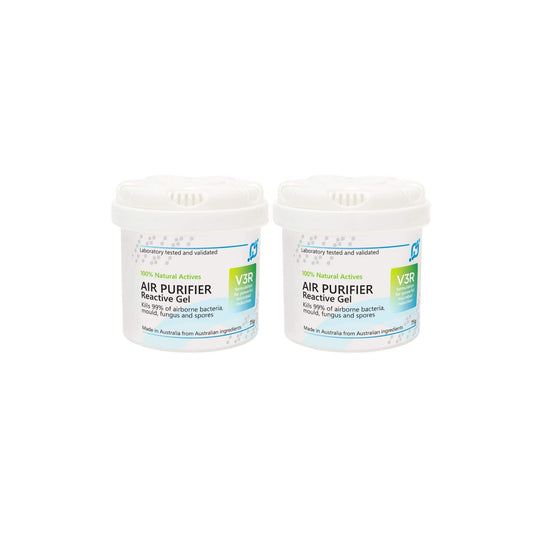
What is mould and how to get rid of it
Share
Mould is a type of fungus that spreads through microscopic spores. Those spores are everywhere, but they only colonise a surface when three things line up at once: moisture, the right temperature and a food source such as dust, soap scum, paper, timber or drywall. Control the moisture and remove that food layer and you break the mould cycle.
Where mould shows up and why
You will most often see mould where air is still and surfaces stay damp: bathrooms and showers, window frames, wardrobes, laundries, under sinks, behind furniture on external walls, and inside air conditioners. Warm, humid air meets a cool surface, condensation forms and lingers, spores settle and growth begins.
Health reasons to deal with mould promptly
Indoor mould can aggravate allergies and asthma and contribute to symptoms like sneezing, congestion, coughing, wheezing and irritated eyes. Musty odours are a clue that spores and microbial by-products are in the air. Reducing moisture and removing growth improves indoor air quality and comfort.
First rule of mould control: fix the moisture
Cleaning alone will not solve a mould problem if the surface stays wet. Before scrubbing, find and fix the moisture source.
- Repair leaks at roofs, windows, pipes and taps
-
Vent bathrooms, laundries and kitchens outdoors with working exhaust fans
-
Reduce humidity with cross-ventilation or a dehumidifier in persistently damp rooms
-
Manage condensation by improving airflow and insulation on cold surfaces
-
Keep furniture a few centimetres off external walls so air can circulate
Aim for indoor relative humidity around 40–60 percent.
How to clean mould safely
Always protect yourself. Wear gloves, a mask and eye protection. Work with windows open and keep children and pets away until everything is dry.
Small areas on hard, non-porous surfaces
Good candidates include tiles, glazed ceramics, sealed benchtops, metal, glass and most painted trims.
-
Dry wipe loose dust so you do not make mud
-
Apply your chosen cleaner such as detergent and water, white vinegar or an appropriate mould remover. Never mix chemicals
-
Agitate with a soft brush or non-scratch pad
-
Rinse or wipe with clean water
-
Dry the area thoroughly and keep it ventilated until fully dry
Silicone, grout and shower glass
Silicone and grout are porous and hold biofilm, so give them more contact time.
-
Pre-clean soap scum with a detergent solution
-
Apply a mould-targeted cleaner and allow the full label contact time
-
Agitate grout with a small brush
-
Rinse and dry completely
-
After showers, squeegee and leave the screen or door slightly open for airflow
Porous materials
Carpet, rugs, ceiling tiles, untreated timber, insulation and water-damaged plasterboard can hold mould below the surface. Light surface spotting on sound timber may be cleaned and dried. If materials are musty, soft or have been wet for more than a day or two, removal and replacement are usually best.
Painted plasterboard and ceilings
If the board is sound and growth is superficial, clean gently with a detergent solution, dry fully, and if staining remains after drying, use a stain-blocking primer before repainting. Address the moisture source or staining will return.
Wardrobes and soft furnishings
Move items out, clean hard surfaces, wash fabrics on a hot cycle if care labels allow and dry in full sun or with warm airflow. Add ventilation or a moisture absorber if the wardrobe is in a cold, external corner.
Tackling mould in and around air conditioners
Air conditioners harbour some of the most common mould hotspots: the evaporator coil, blower wheel and drip tray. Dust plus moisture equals biofilm and odour. A proper at-home clean of the coil, fan and drain restores airflow, removes mould and helps prevent it returning. The Reusable Split System Maintenance Cleaning Kit includes Viper Evap+ solution, coil brushes, a catchment bag, spray and rinse bottles and microfibre cloths so you can do a thorough, mess-controlled clean yourself.
If you prefer a quick ongoing defence between deep cleans, the Anti-Mould Aircon Diffuser sits in your split or ducted unit and works continuously to reduce mould, bacteria and odours. It is a natural, family-safe gel, covers up to 80 m² and typically lasts up to three months before replacement.
-
Kit: Reusable Split System Maintenance Cleaning Kit
-
Diffuser: Anti-Mould Aircon Diffuser
-
Step-by-step how-to: Split System AC Cleaning Kit Instructional Home DIY Kits
Preventing mould from returning
Prevention is mostly about staying dry and dust free.
-
Ventilate during and after showers and cooking until steam clears
-
Squeegee shower screens and tiles and leave doors ajar to dry
-
Keep bathroom fans clean so they can actually move air
-
Dust and vacuum regularly so spores have less to feed on
-
Wipe up splashes quickly and fix small leaks before they spread
-
In winter, avoid cold-then-steamy cycles; use gentle background heating with airflow
-
Maintain your AC: clean filters regularly, deep-clean coils and drains, and use an anti-mould diffuser to keep the air path fresher between cleans.
Common questions
Is black mould the dangerous one
Colour alone does not define risk. Treat all indoor mould as unwanted. Focus on drying the area and removing the growth.
Does bleach work
Bleach can lighten staining on some non-porous surfaces but does not penetrate porous materials. Cleaning plus drying or material replacement is more reliable.
Can I paint over mould
Only after you have cleaned, dried and fixed the moisture source. Otherwise it will bleed back through.
When should I call a professional
If the affected area is widespread, there is significant water ingress, you cannot find the moisture source or you have health concerns.
The takeaway
Mould is a moisture problem first and a cleaning problem second. Fix the water or condensation, remove existing growth and keep humidity down to prevent regrowth. For AC-related mould, pair a proper deep clean with an anti-mould diffuser so your system stays fresher for longer. Start with the kit, add a diffuser for maintenance and use the instructional guide for safe, repeatable results.




